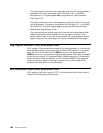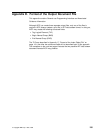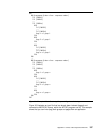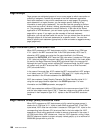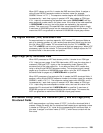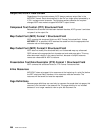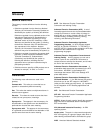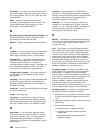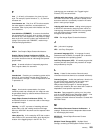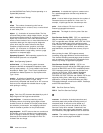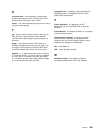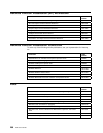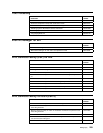architecture. The set of rules and conventions that
govern the creation and control of data types such as
text, image, graphics, font, fax, color, audio, bar code,
and multimedia.
ASCII. American National Standard Code for
Information Interchange data encoding, which is the
normal (default) type of data encoding in an AIX
environment. Contrast with EBCDIC.
B
Bar Code Object Content Architecture (BCOCA). An
architected collection of control structures used to
interchange and present bar code data.
BCOCA. See Bar Code Object Content Architecture.
C
character. One set of symbols used for representing,
organizing, or controlling data. Characters can be
letters, digits, punctuation marks, or other symbols.
character set. (1) A collection of characters that is
composed of some descriptive information and the
character shapes themselves. (2) A group of
characters used for a specific reason, for example, the
set of characters a keyboard contains. (3) Often a
synonym for font character set. See coded font.
carriage control character. An optional character in
an input data record that specifies a write, space, or
skip operation.
code page. Part of an AFP font that associates code
points and character identifiers. A code page also
identifies undefined code points. See also coded font
and default character.
coded font. An AFP font that associates a code page
and a font character set.
copies. See copy group.
copy group. In Print Services Facility, an internal
object in a form definition that identifies the overlays
and defines page placement and modifications to the
form such as paper source or the number of copies.
D
data stream. (1) All information (data and control
commands) sent over a data link, usually in a single
read or write operation. (2) A continuous stream of
data elements being transmitted, or intended for
transmission, in character or binary-digit form, using a
defined format.
document. A file containing an AFP data stream
document. An AFP data stream document is bounded
by Begin Document and End Document structured fields
and can be created using a text formatter such as
Document Composition Facility (DCF).
download. (1) To transfer programs or data from a
computer to a connected device, typically a personal
computer.
(T) (2) To transfer data from a computer to
a connected device, such as a workstation or a
microcomputer. Contrast with upload.
E
EBCDIC. Extended binary-coded decimal interchange
code. This is the normal (default) type of data encoding
in an OS/390 or MVS, VM, or VSE environment.
Contrast with ASCII.
| euro. The monetary unit of the European Monetary
| Union (EMU) that will be introduced alongside national
| currencies on the first of January 1999. In May 1998,
| eleven countries were confirmed for EMU membership
| beginning the first of January 1999: Austria, Belgium,
| Finland, France, Germany, Ireland, Italy, Luxembourg,
| the Netherlands, Portugal, and Spain. On the first of
| January 2002, euro notes and coins (hard currency) will
| be put into circulation, and national currencies will be
| withdrawn, probably over a six-month period.
| EuroReady product. A product is EuroReady if the
| product, when used in accordance with its associated
| documentation, is capable of correctly processing
| monetary data in the euro denomination, respecting the
| euro currency formatting conventions (including the euro
| sign). This assumes that all other products (for
| example, hardware, software, and firmware) that are
| used with this product are also EuroReady. IBM
| hardware products that are EuroReady may or may not
| have an engraved euro sign key on their keyboards.
| EuroReady solution. A solution is EuroReady when
| the solution providers have done the following:
| 1. Analyzed the euro requirements, including the need
| to comply with relevant European Community (EC)
| rules
| 2. Included the appropriate function according to these
| requirements
| 3. Clearly demonstrated this by
| a. detailing the euro-related requirements
| b. describing how these requirements will be
| implemented
| c. declaring when the implementation will be
| generally available
202 ACIF User’s Guide



